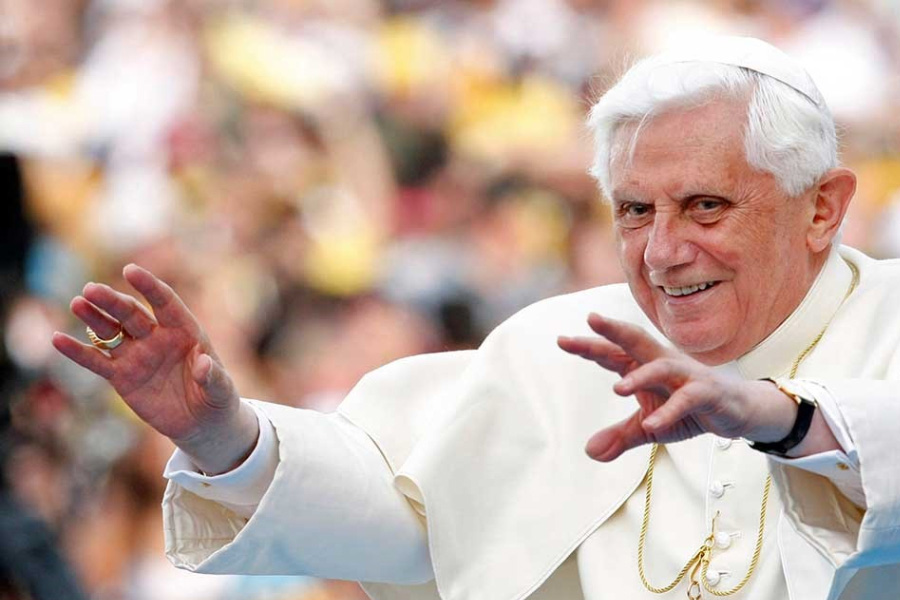
IN MEMORIAM
01-08-2023Weekly ReflectionFr Charlie GoraiebThe following is taken from Benedict XVI — Priest, Prefect, Pope, Rest in Peace, by Edward Petin.
Pope Emeritus Benedict XVI died at the age of 95 on Dec 31. After lying in state and views by hundreds of thousands, he was buried on Jan 5.
Benedict’s pontificate — which began with his election in April of 2005, succeeding Pope St. John Paul II, and ended with his almost unprecedented resignation in February of 2013 -- was peppered by a series of trials, including the clerical sex-abuse crisis, the leaking of confidential papal documents, a Muslim backlash and communication mishaps. At the same time, these years marked a period of liturgical restoration that aimed to reverse the abuses of the past, the initiation of a process of reform of the Curia, most notably in the area of finance, and a continuation of the central themes of the post-conciliar New Evangelization of the Church that had been emphasized throughout John Paul II’s groundbreaking 27-year pontificate.
With Joseph Ratzinger’s death, the Catholic Church loses one of the greatest minds in its 2,000-year history. A leading German theologian who took part in the Second Vatican Council, he rose to worldwide prominence after his 1981 appointment as prefect of the Congregation for the Doctrine of the Faith (CDF).
Those who knew Joseph Ratzinger well, however, regarded him as a gentle and modest man of the Church who was blessed with a scholarly encyclopedic mind and defended the truths of the faith with clarity and power. His episcopal motto was Cooperators Veritatis (Co-workers of the Truth). He was a prophet, unafraid to challenge the perils and emptiness rampant in a world that had thrown aside the Truth revealed by God and nature.
Born on Holy Saturday, April 16, 1927, in the Bavarian town of Marktl am Inn, Joseph Alois Ratzinger was ordained a priest in 1951 and a doctorate in theology in 1957. Because of his brilliant intellect, he was asked to serve as a theological expert at the Second Vatican Council and was influential in the development of the Council’s dogmatic constitution on the Church, Lumen Gentium.
He had been critical of the closed, conformist elements of the pre-conciliar Church and was considered one of the more progressive figures in the Council. But as his progressive-minded peers evoked the “spirit” of the Second Vatican Council, which had concluded in December 1965, to demand sweeping changes to Catholic doctrine and discipline, the Bavarian theologian judged that the ensuing confusion had left many of the faithful adrift.
In 1975, to mark the 10th anniversary of the Council’s conclusion, he authored an article publicly articulating his conviction that the only proper way to interpret the Second Vatican Council was in strict continuity with previous Church councils, such as the Council of Trent and the First Vatican Council. Accordingly, its teachings could not be used to justify a rupture with the continuity of Tradition.
In 1977 Pope Paul VI named Father Ratzinger archbishop of Munich and Freising, and was quickly elevated to cardinal that year. And four years later, in 1981, Pope John Paul II appointed him prefect of the Congregation for the Doctrine of the
Faith. He remained at the side of the Polish pontiff until his death in 2005, serving as one of his closest advisers.
While at the helm of the CDF, Cardinal Ratzinger sought to clarify and defend the faith, address new challenges to Catholic sexual and medical ethics, and end abuses in sacred worship. He was responsible for a host of significant documents, including instructions in the 1980s detailing doctrinal flaws associated with Marxist-oriented liberation theologies, and the 2000 declaration Dominus Iesus, which reasserted the unique salvific role of Jesus and of the Catholic Church. Among his most important contributions was his oversight of the drafting process that resulted in the publication of the Catechism of the Catholic Church. Released in 1992.
Following the death of Pope John Paul II, he was elected pope at the age of 78. He took the name of Benedict XVI, principally after St. Benedict of Nursia, the patron saint of Europe and the founder of Western monasticism. In continuity with his predecessor, Benedict preserved an orthodox position on matters of sexuality, priestly celibacy and ecclesiastical governance.
During his pontificate, Benedict wrote three encyclicals: Deus Caritas Est (God Is Love) in 2005; Spe Salvi (Saved by Hope) in 2007; and Caritas in Veritate (Charity in Truth) in 2009; and four post-synodal apostolic exhortations, including Sacramentum Caritatis (The Sacrament of Charity) on the Eucharist as the source and summit of the Church’s life and mission in 2007 and Verbum Domini (The Word of the Lord) on Holy Scripture in 2010. In these texts, Benedict’s striking gifts as a theologian, philosopher and writer were on display, particularly the luminous clarity of expression and effective mining of central scriptural and liturgical images.Benedict also found time to complete three volumes of his book Jesus of Nazareth.
On Feb 11, 2013, Benedict shocked the world and the College of Cardinals by announcing in Latin at a consistory of cardinals that he would resign at the end of that month, citing age and health concerns. The first pope to resign since Gregory XII in 1415, the now-pope emeritus pledged to serve the Church “hidden from the world” and “dedicated to prayer.” He retired from public life and moved to a converted former convent in the Vatican Gardens but retained several external trappings of the papacy, including a white cassock and zucchetto, and the title of His Holiness.
Regarding his approaching death, Pope Benedict is quoted saying, “In light of the hour of judgment, the grace of being a Christian becomes all the more clear to me. It grants me knowledge, and indeed friendship, with the judge of my life, and thus allows me to pass confidently through the dark door of death.”
Image: portlanddiocese.org
BACK TO LIST